Cnidarians
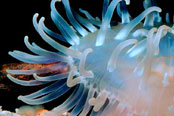 |
|
Flower-like Cnidarian
|
Cnidarians are simple, radially
symmetrical, animals. Radial symmetry means that the body is a hub, like
a bicycle wheel, and tentacles are spokes coming out of it.
Types of Cnidarians
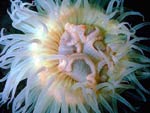 The
Cnidarians include the hydroids, jellyfish, anemones, and corals. All Cnidarians
use tentacles which have stinging cells which are used to subdue and capture
food. The word "Cnidarian" means "stinging creature" in Latin (an old language
that is still used in identifying animals). A stinger can be set off when
a tentacle touches something. The stinger contains a toxin which disables
prey. Most Cnidarians stingers are not powerful enough to do any harm to
people. However, some jellyfish can deliver very painful, and sometimes
fatal, stings to people. The
Cnidarians include the hydroids, jellyfish, anemones, and corals. All Cnidarians
use tentacles which have stinging cells which are used to subdue and capture
food. The word "Cnidarian" means "stinging creature" in Latin (an old language
that is still used in identifying animals). A stinger can be set off when
a tentacle touches something. The stinger contains a toxin which disables
prey. Most Cnidarians stingers are not powerful enough to do any harm to
people. However, some jellyfish can deliver very painful, and sometimes
fatal, stings to people.
Cnidarians can have one of two basic
shapes: polypoid or medusoid.
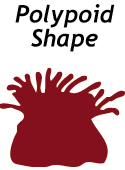 |
 |
| The two
different forms of a Cnidarian body |
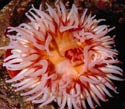 The
polypoid
is the shape of corals and anemones. It is characterized by the mouth and
tentacles facing up, and the other side being anchored to a colony of the
same creatures (like a coral reef). The
polypoid
is the shape of corals and anemones. It is characterized by the mouth and
tentacles facing up, and the other side being anchored to a colony of the
same creatures (like a coral reef).
 Medusoids
are usually free swimmers, like jellyfish. Their tentacles and mouths are
generally pointed down, the opposite of polypoids. Medusoids
are usually free swimmers, like jellyfish. Their tentacles and mouths are
generally pointed down, the opposite of polypoids.
Water Animals & Bowl Animals
The water animals (hydroids) and
bowl animals (anemones, corals) usually live at the bottom of the ocean.
These creatures usually have a polypoid shape, which means their mouths
and tentacles face up while their other side is attached to something.
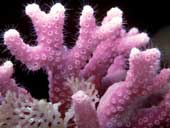 Some
live alone, but others live in colonies (like coral reefs). A coral reef
is really a colony of hundreds or thousands of polyps (which look like
tiny anemones). The polyps live together, anchored to each other, sharing
living tissue and food resources. Some
live alone, but others live in colonies (like coral reefs). A coral reef
is really a colony of hundreds or thousands of polyps (which look like
tiny anemones). The polyps live together, anchored to each other, sharing
living tissue and food resources.
Jellyfish
 Jellyfish
belong to a group of animals called scyphozoans. Jellyfish are not really
fish (they lack a spine and many other adaptations found in real fish).
Jelly"fish" are medusoid in shape and are free-floating—they are not attached
to anything. They swim around the ocean with their mouth and tentacles
pointing down. Some jelly "fish" are very poisonous to humans, occasionally
even fatal. However, most jelly "fish" are not dangerous to people, their
poison will only cause a mild rash similar to poison ivy. Jellyfish
belong to a group of animals called scyphozoans. Jellyfish are not really
fish (they lack a spine and many other adaptations found in real fish).
Jelly"fish" are medusoid in shape and are free-floating—they are not attached
to anything. They swim around the ocean with their mouth and tentacles
pointing down. Some jelly "fish" are very poisonous to humans, occasionally
even fatal. However, most jelly "fish" are not dangerous to people, their
poison will only cause a mild rash similar to poison ivy.
  
|

